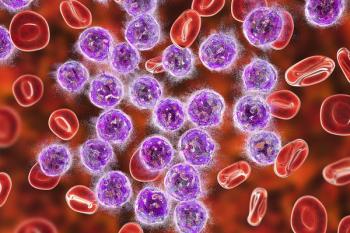
IMM-1-104 Regimens Yield Promising Activity in Pancreatic Cancer

Investigators of a phase 2a trial plan to include additional combination arms assessing treatment with IMM-1-104 across different patient populations.
The investigational MEK inhibitor IMM-1-104, whether administered as monotherapy or as part of a combination regimen, produced encouraging data across 3 small treatment arms including patients with pancreatic cancer, according to a press release from the developer, Immuneering Corporation.1
In the first arm, which included 7 evaluable patients who received IMM-1-104 plus modified gemcitabine (Gemzar) and nab-paclitaxel (Abraxane) for first-line pancreatic cancer, study treatment yielded an overall response rate (ORR) of 43% (n = 3/7) and a disease control rate (DCR) of 86% (n = 6/7) as of December 5, 2024. Investigators reported a favorable tolerability profile for the IMM-1-104 combination; 4 patients remained on treatment at the time of analysis.
“[The] phase 2a data in first-line pancreatic cancer are very promising. If current trends continue, the combination of IMM-1-104 with modified gemcitabine/nab-paclitaxel may provide improved efficacy and tolerability vs gemcitabine/nab-paclitaxel in the first-line pancreatic cancer setting, where patients continue to urgently need better options,” Tanios S. Bekaii-Saab, MD, the David F. and Margaret T. Grohne Professor of Novel Therapeutics for Cancer Research, chair and consultant in the Division of Hematology and Medical Oncology at Mayo Clinic in Arizona, co-leader of Advanced Clinical and Translational Science at Mayo Clinic Cancer Center, and gastrointestinal editorial advisory board member of ONCOLOGY®, said regarding these data.1 “In addition, having a MEK inhibitor that appears to be as well-tolerated as IMM-1-104 may provide new opportunities for patients with different types of cancer.”
Investigators also reported findings from a phase 2a arm assessing IMM-1-104 in combination with modified leucovorin calcium, fluorouracil, irinotecan hydrochloride, and oxaliplatin (mFOLFIRINOX) for patients with frontline pancreatic cancer. As of December 5, 2024, tumor shrinkage and disease control occurred among all evaluable patients (n = 4), which included a 100% tumor reduction for 1 patient. Additionally, the combination regimen was generally well tolerated among patients. Investigators are currently assessing treatment with IMM-1-104 at a dose of 320 mg once daily plus mFOLFIRINOX.
Additionally, initial findings from an arm investigating IMM-1-104 monotherapy for patients with second-line pancreatic cancer were announced. As of December 5, 2024, disease control was highlighted in 11 of 21 evaluable patients, which included a target lesion shrinkage of 67% in 1 patient.
Data showed that IMM-1-104 monotherapy was well tolerated. The most common any-grade treatment-related adverse effects (TRAEs) included rash (29%), diarrhea (24%), fatigue (19%), nausea or vomiting (14%), and blurred vision (14%).
“Having demonstrated compelling activity in both the combination and monotherapy settings for pancreatic cancer, the emerging tolerability profile for IMM-1-104 is also highly promising,” Brett Hall, PhD, chief scientific officer at Immuneering Corporation, stated in the press release.1 “We expect to share expanded development plans for IMM-1-104 beyond pancreatic cancer, as we continue to explore options with investigators and third parties.”
Developers plan to expand the phase 2a trial of IMM-1-104 by including 3 additional treatment arms. According to Ben Zeskind, PhD, chief executive officer at Immuneering Corporation, investigators will assess IMM-1-104 plus a BRAF inhibitor for patients with BRAF-mutated melanoma in 1 arm and IMM-1-104 plus an immune checkpoint inhibitor in 2 other melanoma and non–small cell lung cancer groups. Investigators anticipate launching these arms in 2025.
Investigators of the phase 1/2a study are evaluating the safety, tolerability, pharmacokinetics, and preliminary anti-tumor activity of IMM-1-104 in patients with RAS-mutated or RAS/MAPK-activated advanced or metastatic solid tumors.2 The trial’s primary end points include AEs, dose-limiting toxicities, and the recommended phase 2 dose in phase 1 as well as ORR in phase 2a. Secondary end points include DCR, progression-free survival, duration of response, and overall survival.
References
- Immuneering announces positive data update from three pancreatic cancer arms of ongoing phase 2a trial of IMM-1-104; plans to expand trial with additional arms. News release. Immuneering Corporation. January 7, 2025. Accessed January 8, 2025. https://tinyurl.com/4w5puzbp
- A phase 1/2a study of IMM-1-104 in participants with previously treated, RAS-mutant, advanced or metastatic solid tumors. ClinicalTrials.gov. Updated August 21, 2024. Accessed January 8, 2025. https://tinyurl.com/vejb9fk6
Newsletter
Stay up to date on recent advances in the multidisciplinary approach to cancer.





















































































